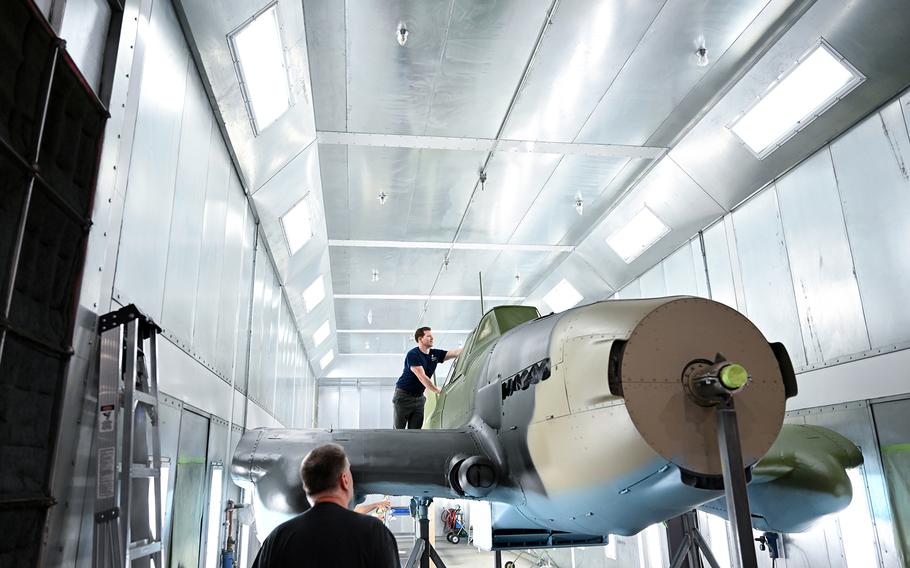
Project lead Tony Hare, bottom left, with museum specialist Jay Flanagan, who is removing paper from the IL-2. (Matt McClain/The Washington Post)
In 1944, a Russian IL-2 warplane was shot down by the Germans near the town of Pustoshka in the western Soviet Union. It crash-landed on a frozen lake. And when the ice melted, the plane sank to the bottom, where it sat for more than 40 years.
Last month, the body of that rugged airplane, rebuilt and freshly painted with camouflage and red stars, gleamed under the lights of a cleaning room in a Smithsonian restoration hangar outside Washington.
“That’s her,” Tony Hare, who is leading the project to restore the plane, said as he stood before the aircraft.
Eighty years after it was downed in World War II and 4,000 miles from where it helped drive back the German invasion of Soviet Russia, the Smithsonian said, the Ilyushin IL-2 is being readied for a historic debut at the National Air and Space Museum in Washington.
When it goes on display in about two years, it will be the first World War II Russian airplane to go on exhibit since the museum opened in 1976, Smithsonian officials said. The museum has had the plane for more than 25 years but has never been able to display it.
The Air and Space Museum, on the National Mall in downtown Washington, has been undergoing an extensive renovation since 2018. Much of the museum is open, but the World War II gallery has been closed. It is expected to reopen, with the IL-2, around 2026.
“There’s very few of these complete IL-2s existing left in the world,” curator Alex Spencer said in an interview at the museum’s Steven F. Udvar-Hazy Center, near Dulles International Airport in Chantilly, Va. “It’s a handful. I think it’s a dozen or less.” The plane is not flyable.
The project comes as Russia is engaged in a new war in Ukraine, which it invaded on a large scale in 2022 and continues to attack with missiles, drones and aircraft. The United States and European countries have condemned the invasion and provided weapons and other support to Ukraine.
But in World War II, Soviet Russia was allied with the United States and other powers against Nazi Germany, and the IL-2 was a big part of that struggle, Smithsonian experts said. The plane was used to attack enemy forces on the ground with machine guns, rockets and bombs.
More than 30,000 IL-2s were built during the war, Spencer said, and it is thought to be the most widely produced airplane of the conflict.
Although the back of the plane was made of wood, the front had thick steel armor, and the Russians called it “the flying tank.”
And although Russian IL-2s suffered heavy losses, they were deadly foes of German ground forces.
They “killed a lot of Nazis,” said Jay Flanagan, a Smithsonian museum specialist who rebuilt the wooden section of the plane.
The restorers said they had no qualms about working on a Russian aircraft, given the war in Ukraine. “It’s all history,” said Hare, the project lead. “We don’t deal with politics. This is an artifact.”
“Our biggest worry, I think, was ... were we going to be told, no, we can’t work on it,” Spencer said. That was not the case.
But because of the war, the restorers have been unable to contact experts in Russia for advice, he said.
“A single email asking a question as to what’s this piece do, or how should this look, or how should we assemble something - we can’t ask those questions anymore,” he said. “I don’t think their government wants us talking to them.”
The IL-2 is “a big beast of an airplane,” Spencer said. The aluminum wings, which are being kept in a separate storage room, will be reattached next month, he said.
The front half of the body is steel. “Every time you try to do something, it hurts you,” said Hare. “This plane bites you constantly. I’ve got so many scars and dings. I even got one today.”
The steel was to protect the pilot. “The pilot was surrounded in armor,” Hare said, adding, “but the poor gunner in the back didn’t have anything.” The rear wooden section provided little protection.
“They replaced a lot of gunners,” Hare said.
The Smithsonian acquired the plane from the Russians through a broker in 1995 in exchange for two old American helicopters that are not flyable. “We had this aircraft on our list of planes from World War II that we wanted,” Spencer said.
He said the plane had been found in the lake in the 1990s near the town of Pustoshka. There was heavy fighting around Pustoshka in the winter of 1944 as the Soviet army pushed the Germans back, according to newspaper reports.
“The story that we have was the pilot and the gunner walked away” after the downing, Spencer said. “The plane landed on a solid lake surface during the wintertime ... and then when the spring thaw took place, the plane just went down to the bottom.”
When it was recovered, it was taken to St. Petersburg and restored by the Russians, he said. After the Smithsonian acquisition, the museum put the plane in storage, where it sat for 26 years.
“Other things and other priorities were always taking place,” Spencer said. “That happens with a lot of our aircraft.” With the new World War II gallery underway, the team had a chance to restore the plane.
But when they began, the team discovered that the wooden part of the plane that the Russians had restored decades before was falling apart. So it was scrapped, and Flanagan, the museum specialist, meticulously rebuilt it over many months, using Russian blueprints and 1,700 individual pieces of wood.
“I built this exactly as the Russians did,” he said. “Exactly.”